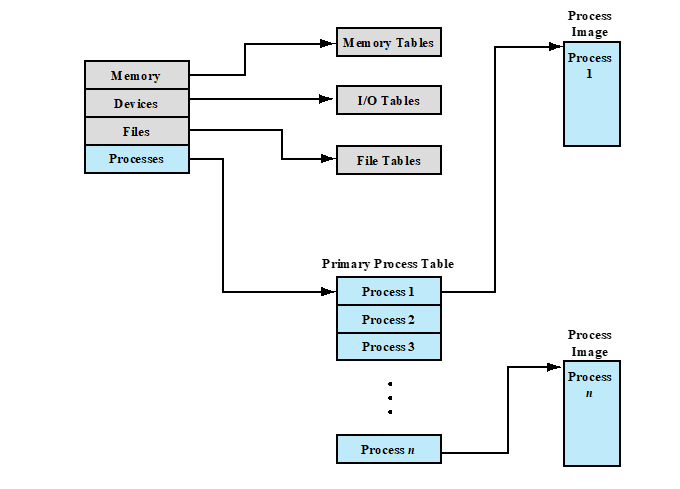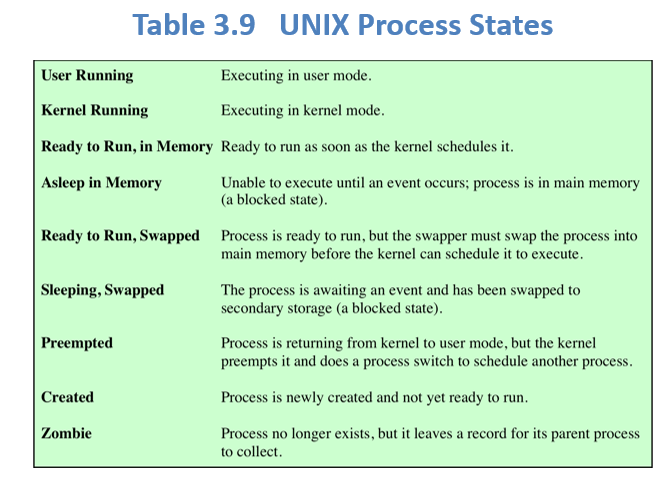Chapter 3 : Process
Process Element
OS keep track of the process using process element
- Program Code(which may be shared with other processes that are executing the same program)
- A set of data associated with that code
while the program is executing,this process can be uniquely characterized by a number of elements, including:
- Identifier: A unique identifier associated with this process, to distinguish it
- State
- Priority
- Program counter: The address of the next instruction in the program to be executed.
- Memory Pointer
- I/O status information
- Accounting information: May include the amount of processor time and clock time used, time limits, account numbers, and so on.
Process States
- Trace: by listing the sequence of instructions that execute for that process
- Dispatcher(调度器): small program that switches the processor from one process to another
Process Execution
Two-state Process Model
at any time, a process is either being executed by a processor or not
a process maybe in one of two states: Running or Not Running
From time to time, the currently running process will be interrupted and the dispatcher portion of the OS will select some other process to run. The former process moves from the Running state to the Not Running state, and one of the other processes moves to the Running state.
- Process control block: help OS keep track of the process, including current state and location in memory
- Processes that are not running must be kept in some sort of queue, waiting their turn to execute.
- A process that is interrupted is transferred to the queue of waiting processes.
- if the process has completed or aborted, it is discarded (exits the system).
- In either case, the dispatcher takes another process from the queue to execute.
Five-state Process Model
看ppt
Suspended Processes(挂起进程)
- –involves moving part of all of a process from main memory to disk
- –when none of the processes in main memory is in the Ready state, the OS swaps one of the blocked processes out on to disk into a suspend queue,The OS then brings in another process from the suspend queue, or it honors a new-process request. Execution then continues with the newly arrived process.
characteristics
- The process is not immediately available for execution.
- The process may or may not be waiting on an event
- The process was placed in a suspended state by an agent: either itself, a parent process, or the OS, for the purpose of preventing its execution
- The process may not be removed from this state until the agent explicitly orders the removal
Process Description
In a multiprogramming environment, there are a number of processes (P 1 ,…, P n ) that have been created and exist in virtual memory. Each process needs access to certain system resources, including the processor, I/O devices, and main memory.

Process P 2 is also in main memory but is blocked waiting for an I/O device allocated to P 1 . Process P n has been swapped out and is therefore suspended.
OS Control Table

Memory Tables
- Allocation of main memory and secondary memory
- protection attributes
- information needed to manage virtual memory
I/O Tables
- Status of the I/O operation
- the source location on main memory
File Tables
•Information may be maintained and used by a file management system in which case the OS has little or no knowledge of files
Process Tables & Control Structure
- some reference to memory, I/O, and files, directly or indirectly
- OS must know:
- Process location
- the attributes of the process that are necessary for its management
Process control block
- Process identification
- Processor state information
- Process control information
Modes of Execution
| User Mode | System Mode |
|---|---|
| less-privileged | –more-privileged mode |
| –user programs typically execute in this mode | –also referred to as control mode or kernel mode |
| –kernel of the operating system |
Process Creation
-
Assign a unique process identifier to the new process.
a new entry is added to the primary process table
-
Allocate space for the process.
-
Initialize the process control block.
-
Set the appropriate linkages.
如果操作系统以链表的形式维护每个调度队列,那么新进程必须放在就绪或就绪/暂停列表中。
-
Create or expand other data structures.
Mechanisms for Interrupting Process Execution
-
Interrupt
–clock interrupt
–I/O interrupt
–memory fault (external)
•Time slice : 进程在被中断之前所能执行的最大时间
-
Trap
在当前运行的进程中生成的错误或异常条件
-
Supervisor call
显式的请求 (call to an OS function)
Change of Process State
- save the context of the processor
- update the process control block
- move the process control block of this process to the appropriate queue
- select another process for execution
- update the process control block of the process selected
- update memory management data structures
- restore the context of the processor to that which existed at the time the selected process was last switched out
Mode Switching
-
No Interrupts
- 进入取指令阶段,在当前进程中获取当前程序的下一条指令
-
an Interrupt is pending the processor
-
It sets the program counter to the starting address of an interrupt handler program.
-
It switches from user mode to kernel mode so that the interrupt processing
code may include privileged instructions.
-
Execution of the Operating System
the concept of process is considered to apply only to user programs. The operating system code is executed as a separate entity that operates in privileged mode.
Execution Within User Processes
中断一个用户程序,使用某些操作系统例程,然后恢复用户程序
during the critical time, the code that is executed in the user process is shared operating system code and not user code.

The view is that the OS is primarily a collection of routines that the user calls to perform various functions, executed within the environment of the user’s process.
Advantage: A user program has been interrupted to employ some operating system routine, and then resumed, and all of this has occurred without incurring the penalty of two process switches.
Process-Based Operating System
to implement the OS as a collection of system processes.
Advantage
- It imposes a program design discipline that encourages the use of a modular OS with minimal, clean interfaces between the modules.
- some noncritical operating system functions are conveniently implemented as separate processes. the function can run at an assigned priority level and be interleaved with other processes under dispatcher control.
- useful in a multiprocessor or multicomputer environment
Unix SVR4
Process State
-
Uses the model where most of the OS executes within the environment of a user process
-
System processes run in kernel mode
-
User Processes
–operate in user mode to execute user programs and utilities
–operate in kernel mode to execute instructions that belong to the kernel
–enter kernel mode by issuing a system call, when an exception is generated, or when an interrupt occurs


(Ready to Run, in Memory) and (Preempted) are essentially the same state, the distinction is made to emphasize the way in which the preempted state is entered.
When a process is running in kernel mode (as a result of a supervisor call, clock interrupt, or I/O interrupt), there will come a time when the kernel has completed its work and is ready to return control to the user program. At this point, the kernel may decide to preempt the current process in favor of one that is ready and of higher priority. In that case, the current process moves to the preempted state. However, for purposes of dispatching, those processes in the Preempted state and those in the (Ready to Run, in Memory) state form one queue.
While a process is running in kernel mode, it may not be preempted!
TWO UNIQUE PROCESSES
- Process 0 系统启动时创建 it is predefined as a data structure loaded at boot time. It is the swapper process.
- process 0 spawns process 1, referred to as the init process; all other processes in the system have process 1 as an ancestor.



